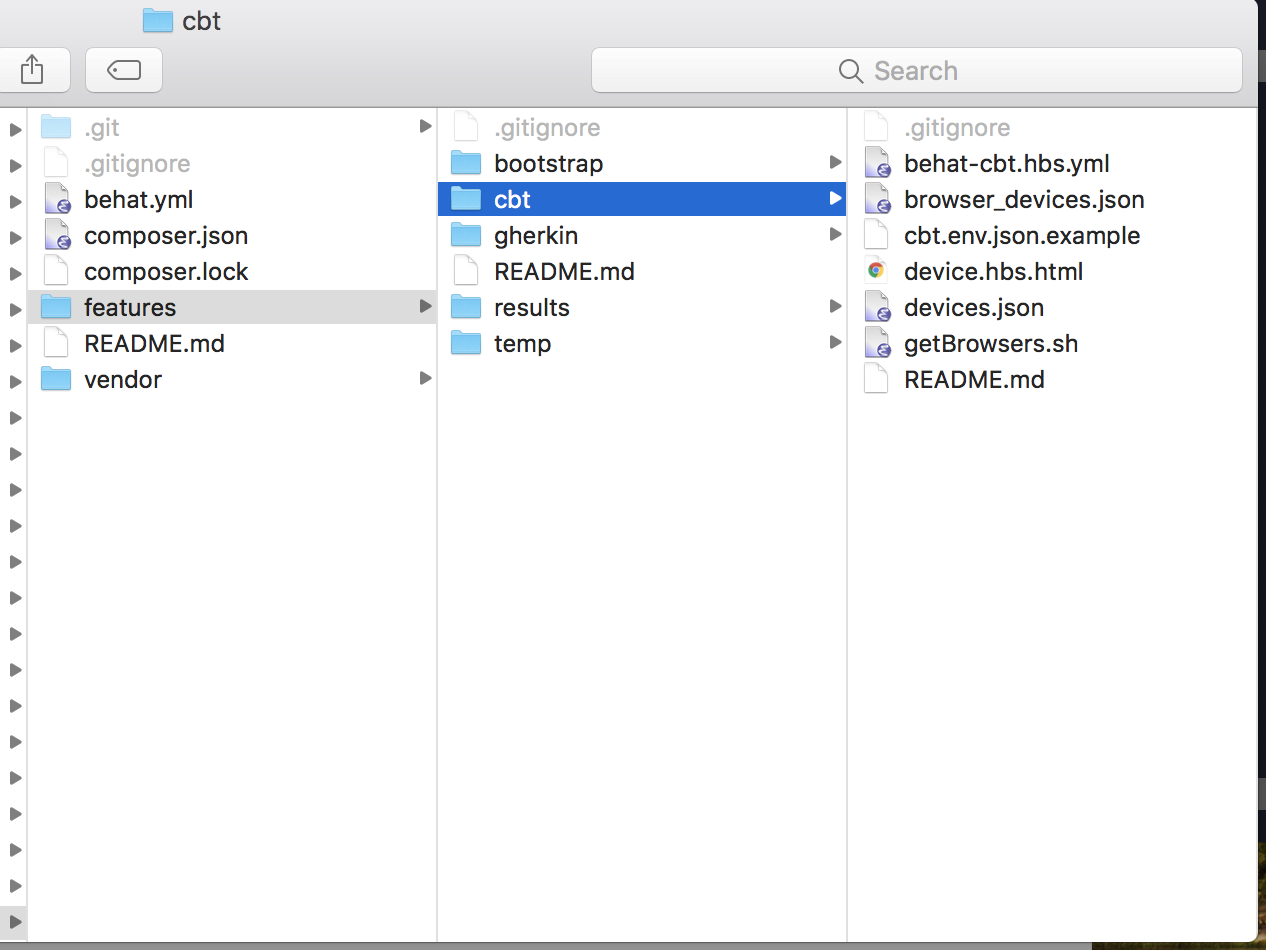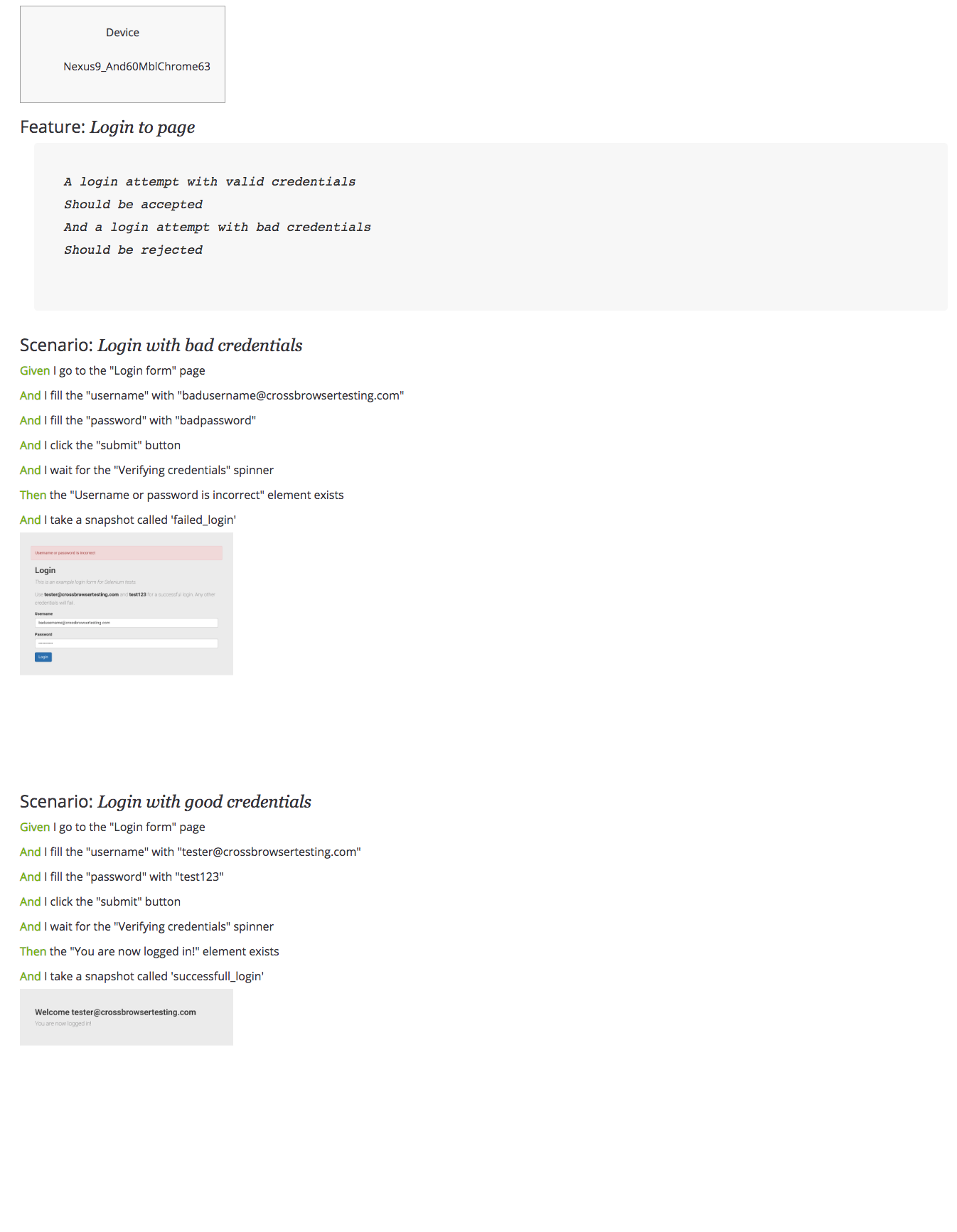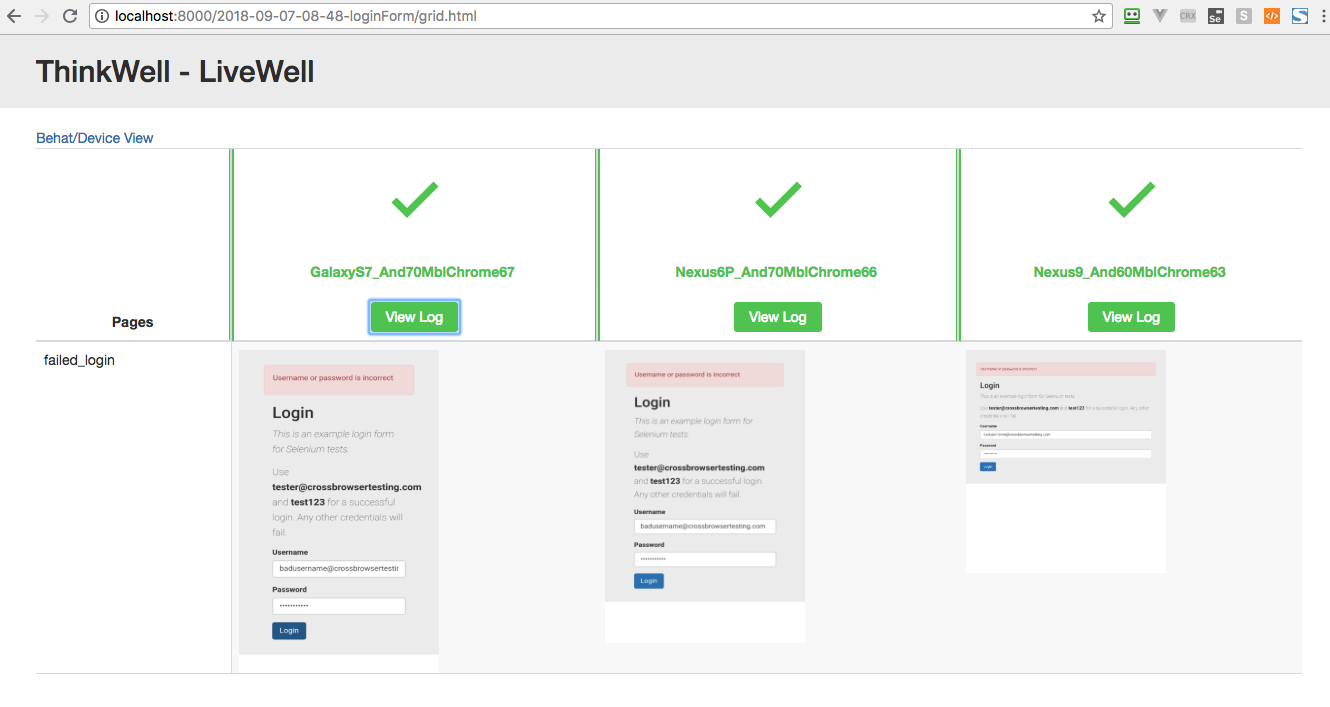Cross Browser Testing
Follow this guide to understand how to QANoErr helps you test with Cross Browser Testing
Directory and files
For running tests on Cross Browser Testing, QANoErr uses the files in the features/cbt directory. The files look like the following:

Let's look at each file:
.gitignore: Ignore the generatedbehat-cbt.yml(not shown) and ignore thecbt.env.jsonauth filebehat-cbt.hbs.yml: Handlebars template for submitting a device/browser to CBTbrowser_devices.json: Some of the device/browsers available for automated testing on CBT.cbt.env.json.example: Examplecbt.env.jsonfile. Edit this file and provide your CBT credentials . Rename it tocbt.env.json. It will not be saved in Git as it isignored. You get these values from https://app.crossbrowsertesting.com/account. When updating this file, be sure to maintain the%40as the@.
device.hbs.html: Handlebars template for producing the Gherkin report.devices.json: The actual device/browser selections to execute. This is a subset of thebrowser-devices.jsongetBrowsers.sh: Script to retrieve all device/browsers available for testing on CBT. Be sure to update theuseridandauthkeybefore runningREADME.md
behat-cbt.hbs.yml
default:
autoload:
'': "%paths.base%/../bootstrap"
suites:
mobile:
paths: ["%paths.base%/../temp/loginForm.feature"]
contexts:
- ProjectContext:
- {{build}}
- {{os_api_name}}
- {{browser_api_name}}
extensions:
Behat\MinkExtension:
default_session: selenium2
browser_name: chrome
base_url: http://crossbrowsertesting.github.io
selenium2:
#wd_host: http://localhost:4444/wd/hub
wd_host: https://{{username}}:{{authkey}}@crossbrowsertesting.com/wd/hub
capabilities:
extra_capabilities:
os_api_name: {{os_api_name}}
browser_api_name: {{browser_api_name}}
build: 1.0.0
record_video: true
record_network: true
max_duration: 1400
new_command_timeout: 1400
SensioLabs\Behat\PageObjectExtension:
namespaces:
page: [pages]
element: [pages]
Let's review this file. The %paths.base% is the current directory, namely features/cbt. We will autoload all the files under bootstrap which is the Context and pages.
We will run one specific script defined in the mobile/paths, namely the loginForm.feature. Update this value to run a different Gherkin.
The ProjectContext takes 3 parameters:
- buildThe directory where the results shall be written.
- os_api_nameThe OS that is being tested
- browser_api_nameThe browser that is being tested.
Next we come to the Behat\Extension and we are running selenium2 and the base_url is provided. This is the URL where CBT will start your mobile app at.
In order to run our test on CBT, we have to provide the wd_host value. If you've created the cbt.env.json with the userid and authkey from CBT, then the wd_host will be setup correctly. You can get your credentials from here https://app.crossbrowsertesting.com/account
The extra_capabilities provides the information that CBT needs:
- os_api_name: The
os_api_namefrom thedevices.jsonfile - browser_api_name: The
browser_api_namefrom thedevices.jsonfile - build: See https://help.crossbrowsertesting.com/selenium-testing/getting-started/crossbrowsertesting-automation-capabilities/
- record_video: See https://help.crossbrowsertesting.com/selenium-testing/getting-started/crossbrowsertesting-automation-capabilities/
- record_network: See https://help.crossbrowsertesting.com/selenium-testing/getting-started/crossbrowsertesting-automation-capabilities/
- max_duration: See https://help.crossbrowsertesting.com/selenium-testing/faq/default-duration-selenium-test-timeout-information/
- new_command_timeout
And finally, the SensioLabs\Behat\PageObjectExtension namespaces are provided.
How to run the test against CBT?
The command vendor/bin/buildCBTTests performs the tests. Let's look at what it actually does.
buildCBTTests starts of by processing the cbt.env.json file which contains the username and authkey. It reads the behat-cbt.hbs.jml to determine what the feature name is and incorporates that into the directory name that will appear under the results file.
It then creates the results directory name under the results file, something similar to 2018-10-01-08-00-loginForm. The name has the Year-Month-Day-Hour-Minute time plus the feature name.
Then buildCBTTests reads the devices.json files. This will be the input data for the handlebars template behat-cbt.hbs.yml
For each device/browser combination in the devices.json file, we first check if there are any CBT Tests running on CBT. Our license only allows us to run 1 Automated test at a time. So buildCBTTests checks if there are any currently running tests and keeps checking until that test is done. ONce there are no active tests, we proceed to start testing the first device.
Each os\browser combination results in numerous files being generated in the results directory. After all the os\browsers have completed, then the GridReport is run. It takes all the results from the os\browser tests and generates the index.html for the Device report and the grid.html.
The Device report looks like this:

And if you select a specific device, it will look similar to this:

If you select the Grid report, it will look similar to this:

With the Device report, you see the Gherkin steps intermingled with the snapshots from running the tests. This report is mainly for the Business to validate the test is correct.
With the Grid report, you have a matrix that shows for each os\browser, a row for each snapshot that was taken. Each row is the same page enabling a quick review that all the responsive devices look correct. If the test had failed for one of the os\browser, there will be a red "X" and by clicking on the "View Log", you can see exactly what failed.
